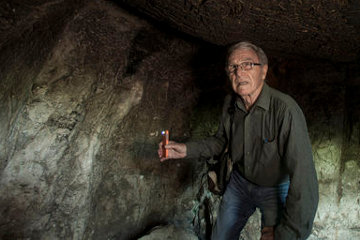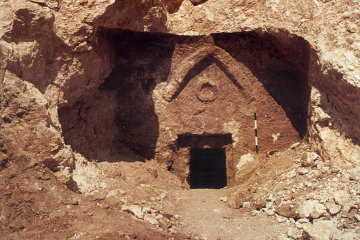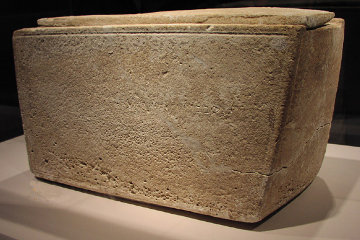Talpiot Tomb Again
| Talpiot Tomb | 31 45 06.52N 35 14 10.19E | The rather blurry picture shows a series of tower blocks. I believe the famous tomb is at the foot of one of these blocks. |

| |
| Dr Arye Shimron, a member of the original excavation team of the Talpiot Tomb. |
According to Dr Shimron, the ossuaries recovered from the Talpiot Tomb were covered with a thick layer of soil characteristic of the hills of East Jerusalem. This soil has a unique "signature" - that is, a unique combination of chemicals, notably magnesium, iron and silicon - which matches the "signature" of the patina on the James Ossuary and therefore "proves" that the ossuary must have come from the same tomb.
The significance of the claim lies in the fact that when the tomb was excavated in 1980, ten ossuaries were found, one of which is now missing, allegedly stolen from the courtyard of the Rockerfeller Museum where the ossuaries were stored. If Dr Shimron's analysis is correct, then it would appear to establish that the James Ossuary is that missing ossuary.

| |
| The doorway into the Talpiot Tomb, as first discovered in 1980. |
The reason why the Talpiot Tomb is the subject of controversy is that a number of the ossuaries found in it bore names which are associated with the family of Jesus. These included Maria, Joseph, Mary, Yose, Matthew, "Judah, son of Jesus" and now - if the Shimron claim is correct - "James, the son of Joseph, the brother of Jesus". Although these names are extremely common in 1st century AD Jerusalem, finding them all together in the one tomb is unusual and one of the arguments used to support the authenticity of the James Ossuary is that although the deceased are commonly identified by their father's name, it is highly unusual to have someone identified by a brother's name. This would only be done if the brother was a famous person. So far as is known, the only "James" from the 1st century AD with a famous brother named "Jesus" is the James mentioned in the Bible.
Naturally the newspapers have leaped on Dr Shimron's announcement, which was made at Easter, 2015, to conclude that Jesus did not rise from the dead but was buried in the Talpiot Tomb, along with other members of His family. In their haste to mock the central claim of Christianity they appear to have discarded their critical facility.
The Talpiot Tomb was discovered in 1980 when builders constructing a new development of Jewish housing uncovered the entrance to the tomb, which was covered with a thick layer of soil. In accordance with Israeli law, the builders reported the find to the authorities and the following day Dr Amos Kloner, a highly respected archaeologist employed by the Israeli Department of Antiquities, visited the site and sketched it, then applied for a permit to conduct a rescue dig. The excavation was conducted by Yosef Gat and there was no doubt that this was the first time the tomb had been opened in modern times (although there was evidence that it may have been disturbed in antiquity).

| |
| The "James Ossuary" showing the famous inscription. |
When Oded Golan, owner of the James Ossuary, was put on trial on a charge of forging the inscription, one of the chief pieces of evidence used by his defence team was a photograph taken in his home in 1976 which shows the James Ossuary on a shelf. The famous inscription was clearly visible in this photograph, establishing that the ossuary in the photograph is indeed the disputed ossuary. At the trial the photograph was used to show that Golan could not have forged the ossuary in the early 2000s because it was in his possession back in 1976. Today we can use the same evidence as proof that the James Ossuary cannot have come from the Talpiot Tomb because it was in Golan's possession four years before that tomb was discovered for the first time!
Then there is the fact that Amos Kloner is categoric that the missing ossuary from the Talpiot Tomb, which he photographed and catalogued, was left in the courtyard of the Rockerfeller Museum because, like so many other ossuaries, it was totally unmarked and therefore of very little significance for the museum's collection. The James Ossuary, on the other hand, not only has the famous inscription, but is also decorated with a rosette. In addition, the measurements recorded by Kloner for the missing ossuary differ from those of the James Ossuary, though there is some dispute as to whether these measurements refer to the same thing. The James Ossuary is not a perfect rectangle and measurements of the top are greater than measurements of the bottom, which is claimed to account for the discrepancy.
The fact that Dr Shimron announced his discovery on Easter weekend, together with the fact that he is, apparently, working with Simcha Jacobvici, who produced the highly controversial film The Lost Tomb of Jesus, must call his scientific detachment - if not his scientific conclusions - into question. However even if his research is eventually published in some reputable journal and passes the test of peer review, all it proves is that the James Ossuary came from Talpiot instead of Silwan, as previously thought. There are numerous tombs in Talpiot and it seems highly unlikely that Shimron's "signature" would be specific enough to eliminate all the other tombs apart from the famous one.
In fact, even that conclusion is highly questionable. Others have pointed out that the limestone soil of Jerusalem, known as "rendzina soil", does not appear to vary very much and a good deal more work would be required to show that the soil in Talpiot is all that different from the soil in - say - Silwan.
There is the additional consideration that if, as Dr Shimron has suggested, Jesus of Nazareth was buried in the Talpiot Tomb and remained there - for bones were found in the ossuary labelled "Jesus son of Joseph" - not only does that demolish the Christian religion, but it makes you wonder why James should call himself "the brother of Jesus". Such a unique reference makes sense if Jesus was a remarkable person - someone, for instance, who rose from the dead - but makes very little sense if Jesus was just another rebel executed by the Romans.
In addition, it lends point to the argument that has often been advanced by Christians, that if Jesus had been buried and remained in His tomb, the claims made by the early Christians about His resurrection could have been easily disproved by the Jewish authorities. Talpiot is only three miles from the Old City and the tomb entrance is ornate - it was not a secret burial in an unknown plot about which the authorities were ignorant.
Apart from the most hard-headed and committed sceptic, no serious historian doubts that the early Christians began to proclaim the resurrection of Jesus within a short time of His death and in the very place where that death took place. Although many historians question exactly what happened on that first Easter - miracles are not very popular with historians - the facts appear to support the claim that within a short time the disciples of Jesus were claiming that He had risen from the dead and provoked a furious reaction from the Jewish authorities. Bribes and threats were used to try and quash this preaching and yet, curiously, the one thing that would have effectually destroyed the early church - producing the body of Jesus - was never done. That is entirely understandable if Jesus was indeed risen and ascended into heaven and entirely inexplicable if His body was quietly decomposing in the Talpiot Tomb.
© Kendall K. Down 2015





